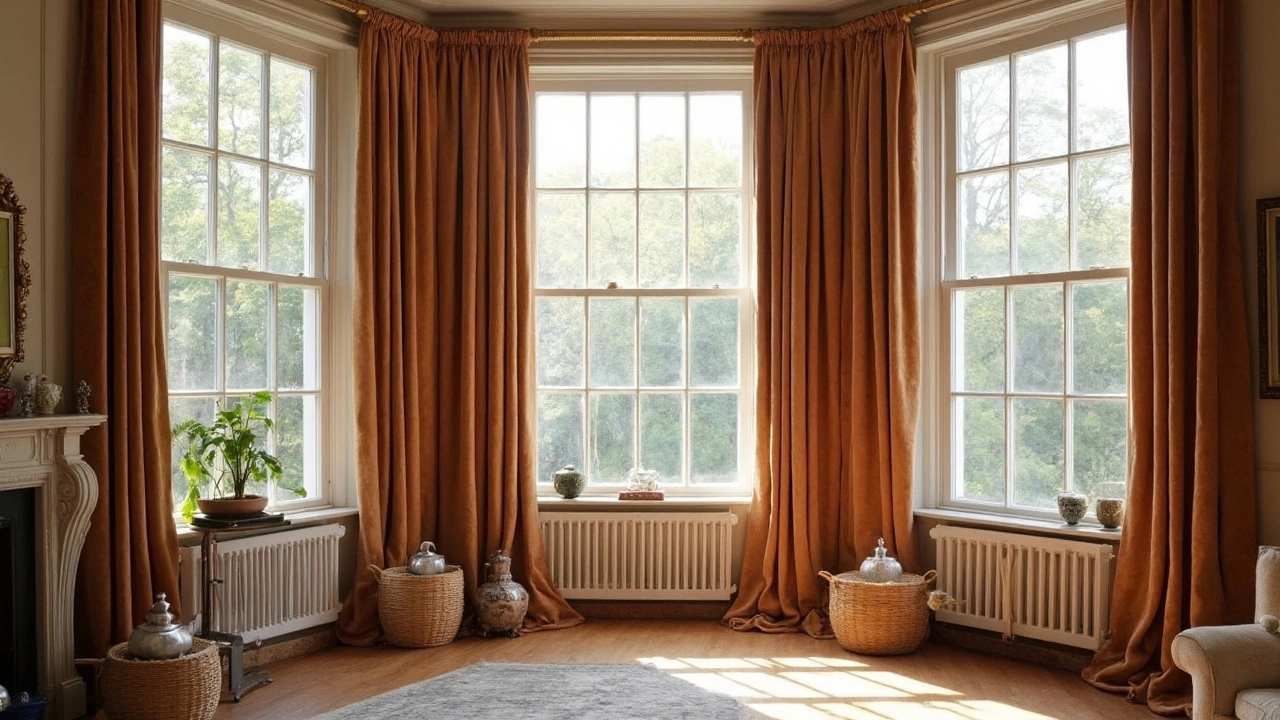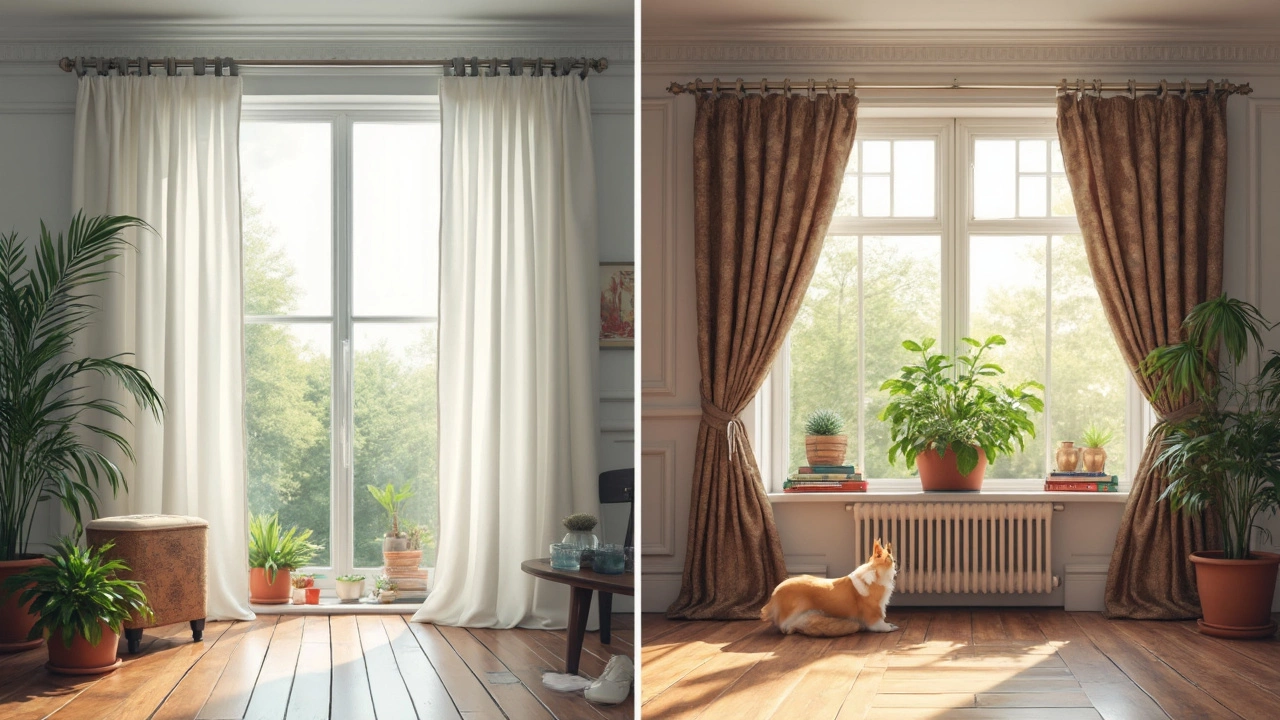Should Curtains Touch the Floor? Finding the Perfect Curtain Length
 Jun, 8 2025
Jun, 8 2025
If you’ve ever stood in the home aisle, curtain panel in hand, and asked yourself, "Am I supposed to let these things touch the floor?"—you’re not alone. Figuring out the right curtain length can actually change how your whole room feels and functions. Go too short, and things look unfinished. Let them pool a little, and suddenly there’s hotel-lobby glam. But there’s more to it than just looks.
Your decision about curtain length isn’t just about style—it can help control dust, block out light better, and even make the ceiling look higher. On the flip side, curtains dragging across the floor can collect dirt or get tangled up in a robot vacuum. Picking the best length depends on who lives in your house (kids, pets?) and how much hassle you want to deal with. You don’t have to follow one-size-fits-all rules—the right length is the one that makes your life easier and your room feel right for you.
- Why Curtain Length Matters
- Pros and Cons of Floor-Touching Curtains
- Matching Curtain Length to Your Space
- Tips for Getting the Perfect Length
Why Curtain Length Matters
People often overlook curtain length, but it actually shapes how a room looks and works. The wrong length can shrink a space or make it look sloppy. The right length pulls things together, makes ceilings seem taller, and keeps light and drafts under control. Turns out, that extra inch or two really counts in home curtains placement.
Let’s break down how different lengths change the overall effect:
- Just hitting the floor: Creates a clean, modern look that works almost anywhere.
- Puddling on the floor: Adds drama and a luxurious vibe, but tends to collect dust and pet hair.
- Hovering slightly above: Feels tailored and makes it easier to sweep or vacuum around, but you need precise measurements to avoid an awkward 'too short' look.
There’s more than aesthetics to think about. For example, hotels often use floor-to-ceiling curtains because they block out more light and help keep rooms cool. The National Sleep Foundation found that dark rooms are linked to better sleep quality, so longer curtains may have real benefits in your bedroom.
| Curtain Length | Common Use | Pros | Cons |
|---|---|---|---|
| Just Touching | Living rooms, bedrooms | Modern, neat look | Requires precise measuring |
| Puddling | Formal spaces | Luxurious style | Harder to clean |
| Floating (0.5-1 inch above) | High-traffic areas | Easy cleaning | Can look short if not exact |
So, the length of your curtains isn’t just about fashion. It’s about function, mood, and how you want to live in your space. With a little planning, you’ll get both style and everyday benefits.
Pros and Cons of Floor-Touching Curtains
So, should your curtains graze the floor or hang higher? It really depends on how you live and what you want from your space. Here's what you need to know before letting those panels hit the ground.
- Looks elevated: Floor-touching curtains can make a room feel taller by drawing the eye vertically. Lots of interior designers, like the folks at HGTV, swear by this trick. Floor-length liners show up even in small rooms to add that wow factor.
- More privacy and light blocking: When curtains fully cover the window and meet the floor, you’re not leaving gaps for sunlight or people to peek in. This is handy for bedrooms or street-facing windows.
- Insulation: Curtains that hit the floor do a better job keeping out drafts in winter and blocking heat in summer. According to the U.S. Department of Energy, snug window treatments can lower heat loss by up to 33%.
- Hides ugly baseboards and uneven floors: If your baseboards are beat up or your floor isn’t totally level, floor-grazing fabric glosses over those flaws without a fuss.
| Pro | Con |
|---|---|
| Makes ceilings look higher | Attracts dust and pet hair |
| Blocks more light and drafts | Can get caught in vacuums or under doors |
| Brings a polished, ‘finished’ style | May trip toddlers or anyone not watching their step |
But let's not ignore the downsides. Curtains that drag on the ground are magnets for dust, especially in busy homes or if you have pets who shed. Cleaning cat hair or snack crumbs off the fabric gets old fast. Shorter curtains dodge this issue, staying cleaner and clearer of trouble. If your floor is uneven or you open windows a lot, long curtains sometimes bunch up or look off.
Some folks love the elegant look of a slight puddle—but too much fabric can be annoying when you need to open or close the panels every day. For homes where safety and cleaning matter, going a little higher (just brushing the floor instead of trailing) is easier to live with.

Matching Curtain Length to Your Space
Not every room needs the same type of curtain setup, so it makes sense to think through what works best for your space before breaking out the hammer and curtain rod. Whether you’re in a tiny apartment or a big open living room, the right length can change the vibe.
Take bedrooms, for example. People usually want blackout curtains that reach as close to the floor as possible, since gaps just let in sunlight. Living rooms, though, can go either way—some folks like a tailored look just above the ground, while others want curtains that graze the floor for extra coziness. Kitchens and bathrooms are usually best with shorter curtains that are clear of spills and splashes.
Want some quick numbers? Here’s a table with general curtain length guidelines for different spaces:
| Room Type | Recommended Curtain Length |
|---|---|
| Bedroom | Touches floor or just skims above (~1/2 inch) |
| Living Room | Touches floor or pools slightly (up to 2 inches) |
| Kitchen | Hangs at or just below window sill |
| Bathroom | Hangs at or just below window sill |
| Home Office | Touches floor or hangs just above |
Don’t forget about your actual window and wall height. The rule of thumb: hang the curtain rod 4 to 6 inches above the window frame, or even closer to the ceiling to make the room feel taller. Standard ready-made curtains usually come in lengths like 63”, 84”, 96”, and 108”. Always measure before you buy—curtain returns are a hassle nobody needs.
If you want a quick visual boost for your space, try letting your curtains just barely skim the floor. Designers say this can actually make the whole room look taller and more put-together. Bottom line—think about how much light and privacy you want, plus how much maintenance you’re up for. Then pick a length that checks all those boxes for your daily life.
Tips for Getting the Perfect Length
Getting curtain length right starts with knowing there isn’t just one “correct” measurement. It depends on your window, floor, and what you want your space to look and feel like. Here’s how to make sure your curtains hit the sweet spot.
- Measure from the rod, not the window. Always measure from where your curtain rod sits, not the top of the window frame. Most folks hang rods 4-6 inches above the window for extra height.
- Decide on a look: Do you want curtains that skim, kiss, or puddle on the floor? Skimming (hovering just above the floor) is neat and easy to keep clean. Kissing (just barely touching the floor) gives a tailored look. Puddling (with fabric pooling by 2 inches or more) looks dramatic but can gather dust.
- Mind the hem: If your floors aren’t perfectly level, measure in a few spots. Go with the longest measurement so your curtains never look too short. You can always have them hemmed to get the perfect fit.
- Standard curtain lengths make shopping easier: Most ready-made curtains come in 84", 96", and 108". For most rooms with standard 8 to 9-foot ceilings, 84" often skims or just touches the floor; 96" works well with higher rods for a more elegant result.
- Leave some width: For fullness, your curtain panels should be about 1.5 to 2 times the width of your window. Bunched, skinny panels look a bit sad and don’t block much light.
To see how the most common curtain lengths compare, check this straightforward table:
| Length (inches) | Best For | Look/Feel |
|---|---|---|
| 84" | Standard ceilings | Hits just above or at floor, clean and classic |
| 96" | High ceilings or raised rods | Touches or puddles on floor, upscale |
| 108" | Very tall ceilings, oversized windows | Dramatic pooling, luxurious |
If you’ve got pets or kids running around, stick to skimming or just-kissing lengths to cut down on mess and tripping hazards. For block-out options, pay attention to the width, too—the more the curtains cover, the less light sneaks in around the edges. When in doubt, aim for slightly too long instead of too short. Tailors can take up a hem, but fabric doesn’t grow.